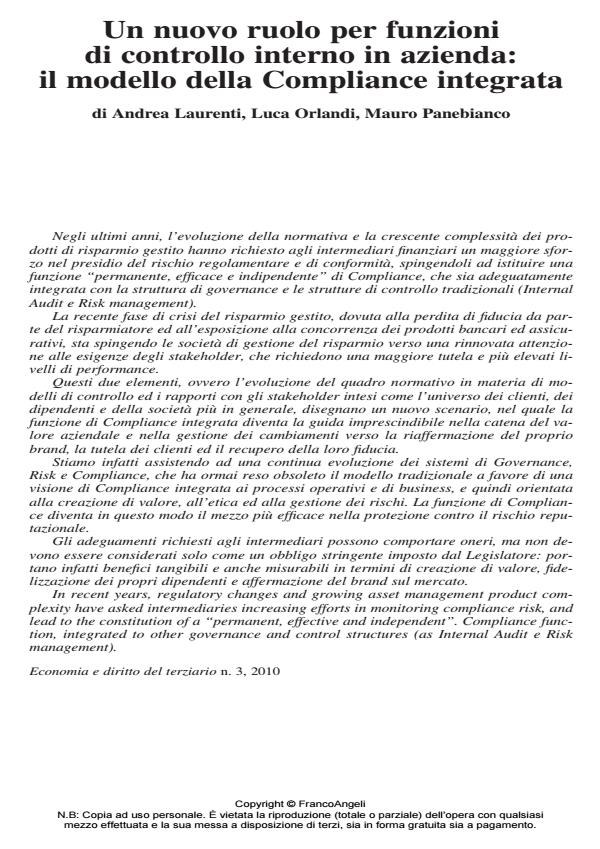Un nuovo ruolo per funzioni di controllo interno in azienda: il modello della Compliance integrata
Journal title ECONOMIA E DIRITTO DEL TERZIARIO
Author/s Andrea Laurenti, Luca Orlandi, Mauro Panebianco
Publishing Year 2011 Issue 2010/3 Language Italian
Pages 20 P. 593-612 File size 948 KB
DOI 10.3280/ED2010-003010
DOI is like a bar code for intellectual property: to have more infomation
click here
Below, you can see the article first page
If you want to buy this article in PDF format, you can do it, following the instructions to buy download credits

FrancoAngeli is member of Publishers International Linking Association, Inc (PILA), a not-for-profit association which run the CrossRef service enabling links to and from online scholarly content.
In recent years, regulatory changes and growing asset management product complexity have asked intermediaries increasing efforts in monitoring compliance risk, and lead to the constitution of a "permanent, effective and independent". Compliance function, integrated to other governance and control structures (as Internal Audit e Risk management). The asset management products crisis, due to investors loss of trust and banking and insurance products competition, is pushing asset manager to pay a greater attention to the needs of stakeholders, asking for increased protection and higher performances. These key drivers - regulatory changes and stakeholder needs - design a new organizational framework in which Integrated Compliance function has a leading role in all company value chain and in managing changes to enhance brand value, protect customers and recover customer loyalty. Governance, Risk & Compliance frameworks are in fact evolving from traditional models to a new vision in which Compliance is integrated to operational and business processes, and aiming at creating value, consolidating ethics and monitoring risk. Compliance function becomes therefore the most effective protection against reputational risk. Needed improvement could generate additional costs, but these interventions should not be considered only as mandatory regulatory accomplishments, as they can lead to significant - and even measurable - benefits in terms of value creation, customer loyalty and brand awareness.
- La prospettiva del "Sistema di Controllo Interno Integrato2 nella Pubblica Amministrazione: riflessioni a partire dal caso Regione Lombardia Enrico Guarini, Francesca Magli, Mauro Martinelli, in MANAGEMENT CONTROL 2/2022 pp.63
DOI: 10.3280/MACO2022-002004
Andrea Laurenti, Luca Orlandi, Mauro Panebianco, Un nuovo ruolo per funzioni di controllo interno in azienda: il modello della Compliance integrata in "ECONOMIA E DIRITTO DEL TERZIARIO " 3/2010, pp 593-612, DOI: 10.3280/ED2010-003010